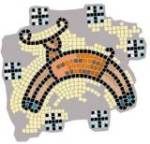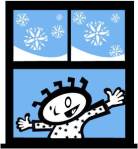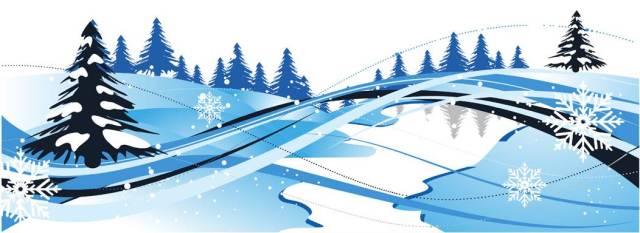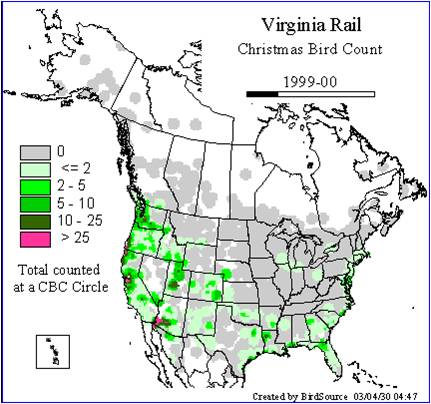In the 19th century, the Christmas “Side Hunt” served as a festive holiday tradition: People chose teams and ventured out to shoot as many birds as they could. The side with the largest pile at the end of the day won. Frank Chapman, from the newly formed Audubon Society, hoped to provide an alternative activity that would bring to the forefront the importance of conservation and concerns about threats to bird populations. So on Christmas Day, 1900, 27 hardy volunteers across North America ventured forth to count all of the birds they could find—alive. Thus was born the annual Audubon Christmas Bird Count (CBC).
Held annually between mid-December and the 1st week of January, the CBC sends out tens of thousands of volunteers across the Western Hemisphere to take a census of every species and each individual bird they can see or hear within a 15-mile-diameter “count circle.” People travel by foot, by car, by ski, by snowshoe, by kayak, by bicycle—and often, various combinations of these. Some are lucky enough to live within the count circle and stay snug and warm, watching their feeders and reporting the birds they see there. All are absolutely vital to the effort. You can find out more at the Audubon CBC Web page.
This page presents information about several related topics: using the Audubon CBC database, an overview of Colorado’s CBCs, a general description of the Salida CBC count circle, specific information about Salida CBC’s Area 4 (the area of the count circle we’ve been covering since the first count in 2003), and my notes from each CBC adventure. Click on any of these links to skip to that section.
 If you’re interested in exploring the historical data, you can go to the Audubon CBC database. At the bottom of this page, you can pick among several options. If you’d like to see actual numbers, you can click on either “by count circle” or “by species.” So, if I wanted the exact count for Salida’s count circle in 2007-2008 (the 108th CBC), I’d choose “by count circle,” select the state (click “find count”), select the count circle within that state (click “add”), choose the year (2007-2008 as both start and end dates), and click “make a table.” I can then download the displayed table as a .csv (comma delimited) file, which I then open (or “convert”) in Excel.
If you’re interested in exploring the historical data, you can go to the Audubon CBC database. At the bottom of this page, you can pick among several options. If you’d like to see actual numbers, you can click on either “by count circle” or “by species.” So, if I wanted the exact count for Salida’s count circle in 2007-2008 (the 108th CBC), I’d choose “by count circle,” select the state (click “find count”), select the count circle within that state (click “add”), choose the year (2007-2008 as both start and end dates), and click “make a table.” I can then download the displayed table as a .csv (comma delimited) file, which I then open (or “convert”) in Excel.
If I were interested in how many Virginia Rails were found in the US during the 108th CBC (2007-2008), choosing “by species” and following the easy-to-use directions shows me that 1,810 Virginia Rails were found on 303 CBCs in the US.
You can also generate a graph of a count of individuals in a species (or more than 1) across years, by clicking on the “make a graph” button. Here, I asked for Virginia Rails in CO from count #100 (1999-2000) to #108 (2007-2008).
The metric of this presentation is a bit non-intuitive—# of birds per party hour. However, the graph includes this explanation:
The graph was generated using the number of birds reported per party hour; a measure of the amount of time spent searching for birds or the amount of effort expended. This is one way to standardize Christmas Bird Count data over time. Some years, there may have been a lot of people counting birds, while other years there may have been fewer participants in the field. As CBC participation fluctuates (and as the number of CBC Count Circles increases), raw count numbers may also fluctuate (more counters can often lead to more birds reported). The graph is one way of correcting for the differences in effort over time. Other types of statistical corrections for differences in effort also exist, and you may download these data for your own use.
The final option on that page—the “find a map” button—wasn’t working as I expected (and probably as was intended). But I was able to get a 10-year “animated” map of Virginia Rails in North America, although only the first year (1999-2000) of the period I asked for shows in the graphic I copied from the Web site. (Odds are that they’ll get this working correctly after data from this year’s CBCs are entered.)
The Web site seems pretty straightforward and self-explanatory, at least to me. So play around with whatever questions might interest you about winter bird populations in the Western Hemisphere.
 Allow me, if you will, to brag just a bit about Colorado. I looked up the number of CBCs listed by state at the Audubon CBC site. You can select the state you’re interested in and see how many CBCs each has. I also looked up the state populations, as of 7/2007. Here are the number of CBCs per million population for the 5 most populous states and CO.
Allow me, if you will, to brag just a bit about Colorado. I looked up the number of CBCs listed by state at the Audubon CBC site. You can select the state you’re interested in and see how many CBCs each has. I also looked up the state populations, as of 7/2007. Here are the number of CBCs per million population for the 5 most populous states and CO.
CA 71 CBCs 36.55 million = 1.94
TX 61 CBCs 23.90 million = 2.55
NY 38 CBCs 19.30 million = 1.97
FL 49 CBCs 18.25 million = 2.68
IL 45 CBCs 12.85 million = 3.50
CO 45 CBCs 4.86 million = 9.26!!!
Well, how about that, sports fans? Does that represent a killer birding community or what? And we can have wicked winters and we don’t even have any coastline (although IL should feel pretty good about its ratio, also not having at least a sea coastline…).
Statistical caveats here. I cheated a bit, because the state-wide COBIRDS listserve noted that 6 traditionally held CBCs had not yet posted on the Audubon Web site at the time I checked, so I added them in. (Other states may have had similar lacunae, but I didn’t add them in.) But even if you increase the other count numbers by 20% (using CO’s 15% missing as a guide), CO still rocks. Also, as a numbers geek, I should acknowledge that, in less populous states, each CBC “counts” more than in more populous states. And the more populous states have greater proportions of their population in urban areas, where fewer CBCs per capita might be expected. But caveats aside—CO rules!!!
 Zell and I began our participation in CBCs in 2003, when Salida offered its inaugural CBC. An ornithologist friend of ours had been trying to convince us for years to participate in one of his CBCs, but we just couldn’t find the time or the energy or the enthusiasm. However, since Salida is only 18 miles away from our house in Coaldale, this seemed like an interesting and convenient opportunity to meet some local birders and learn more about birding in the Salida area. Little did I know how much fun it would be and how it would become a valued holiday tradition for us. Once our friend learned that we were going to get involved, he volunteered to drive 3 hours from his home in the eastern plains to join our team. (Yes, birders are just that crazy.) Knowing what a terrific birder he is, we happily accepted his offer to be our team’s “ringer.”
Zell and I began our participation in CBCs in 2003, when Salida offered its inaugural CBC. An ornithologist friend of ours had been trying to convince us for years to participate in one of his CBCs, but we just couldn’t find the time or the energy or the enthusiasm. However, since Salida is only 18 miles away from our house in Coaldale, this seemed like an interesting and convenient opportunity to meet some local birders and learn more about birding in the Salida area. Little did I know how much fun it would be and how it would become a valued holiday tradition for us. Once our friend learned that we were going to get involved, he volunteered to drive 3 hours from his home in the eastern plains to join our team. (Yes, birders are just that crazy.) Knowing what a terrific birder he is, we happily accepted his offer to be our team’s “ringer.”
While Coaldale is in western Frémont County, Salida is in Chaffee County. The organizer (called the Compiler) of the Salida CBC has written a nice summary of birding spots in Chaffee. (Since this write-up describes the entire county, it covers more territory than just the CBC count circle.) The Salida CBC is considered a mountain CBC, starting at an altitude of 7000′ with the majestic Sawatch Range and the towering Collegiate Peaks of the Rocky Mountains directly to the west. But the area has a surprising variety of habitats that one wouldn’t expect in a mountain CBC. For instance, the presence of geothermally heated water creates some interesting microhabitats. As discussed on Salida.com,
…the Arkansas River runs between two long faults in the area. The water follows some of these faults, putting it in contact with a heat source deep within the earth. The heat flow within the earth’s crust in the Arkansas River valley is nearly triple that of normal heat in the earth’s crust. When combined with the valley faults, this extraordinarily high temperature can deliver the water to great depths, heat the water, and return it to the surface.
As a result of this geothermal energy, several farm ponds and seeps provide open water in even the bleakest of winters for occasional vagrants such as Trumpeter Swans, Green-winged Teal, and even a Rusty Blackbird. A large wetlands also has open water moving through cattails, offering surprises such as Virginia Rail, Swamp Sparrow, and Marsh Wren.
In addition, the Arkansas River itself courses through the heart of town, hosting Common and Barrow’s Goldeneyes, Common Mergansers, and an occasional Northern Pintail—in addition, of course, to scores of Mallards and thousands of Canada Geese and a few Cackling Geese. Even more intriguing is Sands Lake—a settling pond just downstream from a state fish hatchery. Warmed by the water from the hatchery, Sands Lake is completely open and toasty all winter. So all sorts of waterfowl congregate there. Some of the interesting “mountain” waterfowl have been Greater Scaup, Eared and Horned Grebe, and Bufflehead. A group of Great-tailed Grackles typically hangs out there, as well. Keep in mind—these birds have all been spotted ~15 miles from the Rocky Mountains, at 7,000′ within 2-3 days of the winter solstice! And of course, the count circle has mountain areas as well, allowing the CBC to “tick” such alpine goodies as Gray Jay and 2 species of Rosy-Finch. This outstanding diversity of habitats—all within a 15-mile-diameter circle—makes the Salida CBC routinely one of the best and most varied mountain CBCs in the state.
Another very special aspect of the Salida CBC is the consistent involvement of the local Division of Wildlife (DOW). Since the beginning, they’ve been staunch supporters of the CBC: They let us meet in their conference room; they provide food; they suggest–and sometimes even help counters get to—important habitats that can be snowbound; and the regional and area managers allow the staff to do all this “on the clock.” Such instrumental support clearly sends a strong message to the community and the state about the importance of avifauna.
 Our team of Zell, our friend from the plains, and me (and, in the past 3 years, a 4th friend) has had basically the same area—Area 4—since 2003. We pretty much just lucked into this nicely varied area the first year. But as it turns out, the wetlands is a critical habitat for some species that can only be found there. Since our ornithologist friend makes his living working with waterfowl and shorebirds at a large reservoir in eastern CO, his familiarity with and skill at identifying these species are invaluable to the count. And since familiarity with the special spots of an area is a tremendous asset in finding species year after year, we have continued to work this area to within an inch of its life.
Our team of Zell, our friend from the plains, and me (and, in the past 3 years, a 4th friend) has had basically the same area—Area 4—since 2003. We pretty much just lucked into this nicely varied area the first year. But as it turns out, the wetlands is a critical habitat for some species that can only be found there. Since our ornithologist friend makes his living working with waterfowl and shorebirds at a large reservoir in eastern CO, his familiarity with and skill at identifying these species are invaluable to the count. And since familiarity with the special spots of an area is a tremendous asset in finding species year after year, we have continued to work this area to within an inch of its life.
Area 4 cover the following areas:
- Frantz Lake and Mt. Shavano State Fish Hatchery;
- Mt. Ouray State Wildlife Area, a former fish hatchery that encompasses a large wetlands that has had open water every winter
- a large portion of the Arkansas River;
- Fairview Cemetery;
- and several private farm ponds and seeps that are heated by the underground geothermal energy.
 After each CBC, I wrote a bit about the experience to try to retain the sense of adventure, teamwork, and fun I had had during the day, as well as to make notes about what I was learning about winter birds in the area. The names have been reduced to first initials, to protect the innocent (or the guilty, as the case may be). Keep in mind that these are more like short “notes to self” than fine prose. But you can perhaps get a sense of what a CBC day is like, at least for us. You can find them by clicking on these links: 2003 (our maiden CBC voyage); 2004 (the year of the Rusty Blackbird); 2005 (the year without Sands Lake, with only 1 ringer–and Eastern Bluebirds!); 2006 (the CBC that almost wasn’t); 2007 (the year of Bohemian Waxwings); 2008 (the end of swampies?); 2009 (where have all the birdies gone?); and 2010 (the return of fun—and a swampie!).
After each CBC, I wrote a bit about the experience to try to retain the sense of adventure, teamwork, and fun I had had during the day, as well as to make notes about what I was learning about winter birds in the area. The names have been reduced to first initials, to protect the innocent (or the guilty, as the case may be). Keep in mind that these are more like short “notes to self” than fine prose. But you can perhaps get a sense of what a CBC day is like, at least for us. You can find them by clicking on these links: 2003 (our maiden CBC voyage); 2004 (the year of the Rusty Blackbird); 2005 (the year without Sands Lake, with only 1 ringer–and Eastern Bluebirds!); 2006 (the CBC that almost wasn’t); 2007 (the year of Bohemian Waxwings); 2008 (the end of swampies?); 2009 (where have all the birdies gone?); and 2010 (the return of fun—and a swampie!).
Also, you can find a summary table of the Salida CBC’s species counts by year here. (It’s a spreadsheet on Google.doc—perfectly legitimate, in case you were wondering.)
So if early winter aeterna’s what’s troublin’ you, Bunky—consider joining up with a CBC team to help census whatever avifauna are courageously hanging out in your neck of the woods in the winter. And enjoy some great team-oriented camaraderie with fellow birders.
© 2008 Tina Mitchell







